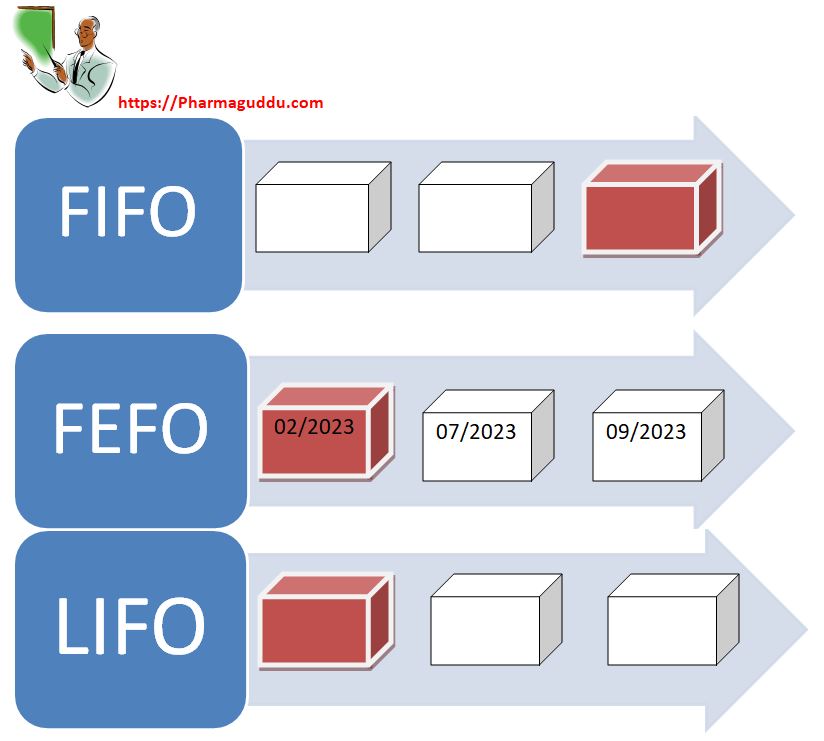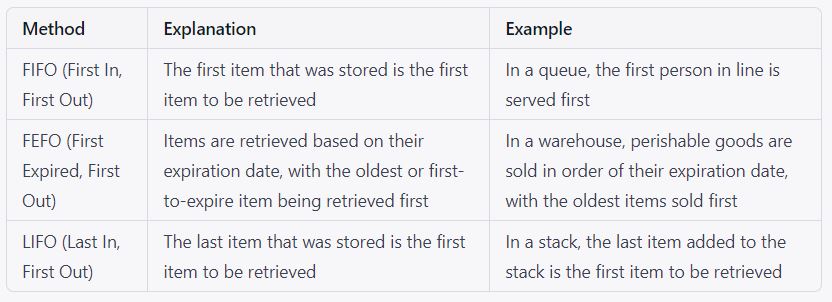FIFO, FEFO, and LIFO are three different methods used in inventory management, warehouse management, and Pharmacy management to determine the order in which items are sold or used. Let’s understand the difference between FIFO, FEFO, and LIFO.

What is FIFO
FIFO Principle stands for “First In, First Out,” meaning that the first item that was stored in a warehouse or store will be the first item to be sold or used. This method is commonly used in inventory management to minimize the usage risk of outdated products and reduce waste.
FIFO Guidelines
The guidelines on good distribution practices for pharmaceuticals intended for human use (94/C 63/03), which are no longer in effect, called for “a method to ensuring stock rotation (“first in first out”) with regular and frequent inspections to ensure the system is running effectively. The statement said, “Products returned to saleable stock should be placed so that the ‘first in first out’ approach works efficiently.
What is FEFO
FEFO Principle stands for “First Expired, First Out,” and is used specifically for perishable goods, such as food, pharmaceuticals, and pharmacy. The FEFO method ensures that the oldest items are sold or used first, which minimizes the usage risk of outdated products and reduces waste.
Related: Difference between GMP/cGMP
FEFO Guidelines
The FEFO approach is preferred by the EU GDP Guidelines (Guidelines of 5 November 2013 on Good Distribution Practice of Medicinal Products for Human Use – 2013/C 343/01). It is mentioned in Chapter 5.5. (Storage) that “As per the “first expiry, first out” (FEFO) principle, the goods stock should be rotated. Exceptions must be recorded.” “Products returned to saleable stock should be arranged such that the ‘first expired first out’ (FEFO) system operates successfully,” states Chapter 6.3 (Returned Medicinal Products).
Good storage and distribution methods for medical items are in accordance with the WHO (Annex 7, WHO Technical Report Series 1025, 2020) “Materials and health products should be stored in ways that assure the maintenance of their quality. Rotating stock should be done properly. It is best to adhere to the “first expired/first out” (FEFO) rule.”
What is LIFO
LIFO Principle stands for “Last In, First Out,” meaning that the last item stored in a warehouse and pharmacy store will be the first item to be sold or used. This method can be useful in inventory management for items that have short shelf lives, as it helps to reduce the usage risk of outdated products.
LIFO Guidelines
WHO’s “Good storage and distribution methods for medicinal items” includes a reference to LIFO (Annex 7, WHO Technical Report Series 1025, 2020)
Difference Between FIFO, FEFO, and LIFO

Final Conclusion
In conclusion, FIFO, FEFO, and LIFO are the methods that are used in the management of inventory in warehouses in pharmaceuticals, and Pharmacy chains to determine the order in which items are sold or used. The methods that are going to be used are decided as per the requirements.
Frequently Asked Questions (FAQs):
a. FIFO stands for First In, First Out
a. FIFO retrieves the first item stored, while LIFO retrieves the last item stored in a warehouse.
a. FEFO method used for near-expiring goods, such as food, pharmaceuticals, and Pharmacy stores.
a. To minimize and management of near to outdated items and reduce waste by selling the oldest items first in a warehouse management system.
a. The last item stored is the first item retrieved in an inventory management system using the LIFO method.
a. By selling the oldest items first, the FEFO method helps reduce the waste products in the warehouse.

Naresh Bhakar is the Founder and Author at Pharmaguddu.com, bringing his extensive expertise in the field of pharmaceuticals to readers worldwide. He has experience in Pharma manufacturing and has worked with top Pharmaceuticals. He has rich knowledge and provides valuable insights and data through his articles and content on Pharmaguddu.com. For further inquiries or collaborations, please don’t hesitate to reach out via email at [email protected].
